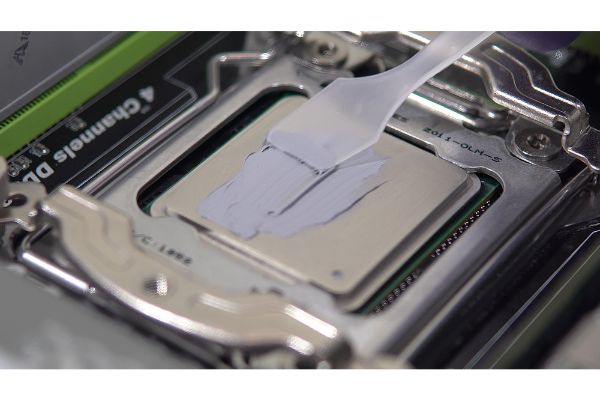Disclaimer: This post may contain affiliate links, meaning we get a small commission if you make a purchase through our links, at no cost to you. For more information, please visit our Disclaimer Page.
Just like their larger cousins, laptops also have central processing units to handle many of the tasks they need to perform for you. And, also like desktops, those CPUs can get a little hot when they’re working hard all day. In both cases, manufacturers add thermal paste to the CPUs in order to help them stay cool.
The consistency between different thermal pastes can vary a bit, but you’ll be looking at something that closely resembles a glue-like compound that you can squeeze from a tube.
Yes, you can use thermal paste on a laptop CPU to ensure that things don’t run too hot.
We’ll take you through when you might put thermal paste in the laptop, if there are times when you don’t need it, how to change it, and more specifics in our article below.
Table of Contents
Should You Put Thermal Paste on Laptop CPU?
The answer to this question is one of those curious yes and no types. Yes, you should put thermal paste on your laptop if there is none on it already. We’ll get into the specifics of how thermal paste plays an important role in the next section.
For now, it is worth noting that any new laptop should already include thermal paste when you get it. In most cases, you won’t need to put thermal paste on your new laptop. There are exceptions that we should go over, however.
1. In rare cases, some manufacturers may not always use the best thermal paste or proper application of it. While re-pasting new machines used to be more common, most manufacturers of modern laptops use decent paste that should last you for several years.
2. If you find that your machine is still relatively new yet experiencing overheating problems, bad or improperly applied paste could be the culprit. In such cases, yes, you may need to apply thermal paste to your laptop yourself.
3. Whether or not you need to apply some paste, it is a good thing if your laptop CPU has some thermal paste it can make use of in order to help the transfer of excess heat from the CPU to the heatsink.
4. If you purchased a used laptop and you find that there’s overheating issues, you may need to replace the thermal paste.
Do You Always Need To Use Thermal Paste on Laptop CPU?
Some users have wondered if they might be able to run their laptops without any thermal paste at all. While there is always the possibility that your laptop could perform some simple processes that are not too intensive with resources and still be fine, but this could come at the cost of performance or other issues.
Namely, you could be looking at a decrease in your laptop’s overall function. Fans might run loudly, the device itself might run hot, or things might seem sluggish.
It could get particularly slow if you are trying to do intense tasks or multiple processes at once. If the problems persist, your laptop might attempt to shut itself down regularly as a way to reduce the buildup of heat and protect sensitive components.
In short, even if you could run some processes on a laptop without any thermal paste to keep things cool, it poses a threat to the device and is not recommended.
How Can I Change Thermal Paste on Laptop CPU?
If you’ve determined that old, dried, or missing thermal paste is the cause of some of your laptop’s woes, here are some basic steps you can follow to change it:
1. Flip the entire laptop over so that you are looking at the bottom of it. Slide the battery release latch to the side so that the battery pops up. Once you have removed the battery, you may wish to press the power button a few times.
2. Use an appropriate screwdriver to unscrew and remove the service door on the bottom of the laptop. When you can see the components inside, carefully unseat the hard disk from its base and set it aside.
3. At this point, you’re ready to release some of the components, but it is a good idea to clean dust and debris from everything first. A small brush with antistatic properties that is made for laptop cleaning is what works best here.
4. Release and remove the heatsink and fan. Be careful to keep the fan and heatsink connected tightly as you are removing them. A strip of adhesive should be holding them together.
5. If you see any old thermal paste still on the CPU, you can use a clean cloth made from microfibers and some thermal material remover to get it off gently. You may also wish to apply a special cleaner to the CPU and heatsink here as well. Wipe them dry gently and with a clean cloth.
6. Take your new thermal paste and apply a very small amount about the size of a grain of rice.
7. Once the thermal paste is applied properly and there is no mess, it will be time to reinstall the other components you removed from the laptop. Namely, you’ll need to reinstall the heatsink and fan. Make sure everything is reconnected as it should be before closing up the laptop.
8. Besides proper connections, make sure all the components are seated properly and evenly within the laptop housing. Screw things in securely where appropriate, but don’t apply a ton of force to holding down the components.
There is no need to overwork the screws either, but use the screwdriver to seat them snugly inside their holes, but don’t overturn them. You don’t want to risk stripping the heads.
How Long Does Thermal Paste Last in a Laptop?
Different people may give you some different answers to this question. In most cases, you’ll find that good thermal paste is supposed to last for at least three to five years. Many users expect their thermal pastes to last much longer, however. Particularly with laptops, you may find that your thermal paste is holding up well beyond the recommended minimum shelf life.
Even if your laptop is older than five or seven years, you might not notice any significant performance issues. There are apps that can monitor the heat inside your laptop both when it is idle and when it is operating under a heavy load of processes.
Provided these things are staying within the recommended ranges, it is probably a safe bet that your laptop’s thermal paste is holding out. Because swapping out the paste can be a complex process, it may be a good idea to assume it is doing its job as long as things are staying cool.
How Often Do I Need To Change Thermal Paste on Laptop CPU?
The true answer to this question really depends on what thermal paste was applied and how. Assuming that the manufacturer used decent thermal paste and applied it properly, there is no reason to disassemble and try to replace the paste in your laptop regularly.
It is important to keep in mind here that this view also assumes you are not experiencing any problems with overheating or performance when running your laptop.
If everything is working fine as far as you can tell, you shouldn’t need to worry about replacing the thermal paste in your laptop. In our previous section, we went over how there is at least a minimum recommended range for how long good thermal paste should last. This is only a general guideline.
Laptops can be trickier to disassemble and reassemble than their PC counterparts. If you are not sure how to do something, or if the laptop is running fine, it is probably best not to mess with its internal components.
Of course, sometimes you might need to get in there and do something, and that is why we’ve gone over how you might swap out your thermal paste.
Conclusion
Laptops work as hard as their desktop counterparts at times, and they need a way to stay cool. Just like in a desktop computer, this is where thermal paste comes in. It works well for laptops too, and it needs to be applied in the same careful way for the best results.
Mostly, you’ve learned that quality laptops from good manufacturers should already include thermal paste that should suffice for years to come. However, we’ve also gone over some of the more exceptional cases where this might not hold true, and we’ve explained what you might be able to do to solve the problem yourself.
In either case, a small application of a bit of thermal paste should keep your laptop’s parts running smoothly for a long time, and your CPU will thank you for it.


